
|   |

|   |
The Udayaraga Festival - Probal Gupta, Bangalore e-mail: probs_gupta12@yahoo.co.in Photos: Orissa Dance Academy April 7, 2011 The Udyaraga festival of Odissi 2011 conducted by Orissa Dance Academy under the leadership of Aruna Mohanty showcased immensely talented male Odissi dancers of which the state Odisha is presently blooming with, along with young talented female Odissi performers. 26th March commenced with three Odissi dancers - Pravat Kumar Swain (Bhubaneshwar), Shivali Pattanaik (USA) and Supriya Nayak (Delhi), all commencing their recital together with Mangalacharan in praise of Lord Ganesha - the remover of all obstacles. One must commend Aruna's beautiful idea of commencing the evening with the combination of two female dancers and a male Odissi performer. Pravat's entry was followed by the two girls in slow momentum with a swara followed by the traditional encomium to Lord Jagannatha "Jagannatha swami nayana patha gami…." The dancers moved in conscientious flow on the stage drawing various spectacular geometrical patterns.  Shivali Pattanaik The first item of the evening 'Konark Kanti' was an apt beginning by Shivali. Odissi being influenced by the sculptures as engraved in the Konark temple, fine refinement in body postures is definitely required. Shivali's fine body structure was definitely an added advantage. Set to Raag Bhoopali and Shankarabaranam in eka taali, the item is a choreography of Late Guru Gangadhar Pradhan. The "dha kita dhat ta" swara displayed the sculptures in Konark playing various musical instruments. Shivali's zest brought out the required potential to execute such a brilliant choreography. "Ghumu Ghumu Ghungroo, dibi dibi…. nada bhyankara Shiva bhyankara" along with her neat footwork precisely matching the swara "thaka thai indta kara taka ta ham ta hata tai" with the graceful lilting of the upper torso continued shifting through an enchanting rhythmic phrase. The 'S' curve as created during the asymmetrical tribhangi position along with the beautiful permutation and combination of chowks and charis proved the dancer's grit on the minute nritta technicalities. The ashtapadi "Pashyati dishi dishi" with Radha pining for Krishna in his absence and longing to unite with the supreme soul, a beautiful choreography by Aruna Mohanty with Krishna being compared to Vishnu as Ananta Sayana during a sanchari needs subtlety in abhinaya. What the dancer needs to master is the internalization of mukhabhinaya, especially where Radha imagines Krishna kissing her in reverie and the bewilderment on her face as she comes out of her dream, pining for the supreme. 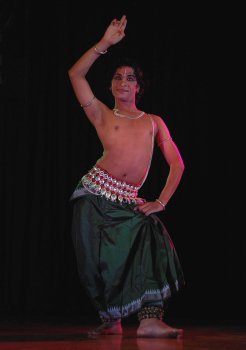 Pravat Kumar Swain Pravat Kumar was by far the best in this series of Udayaraga festival. Demanding stage presence, neat and measured nritta and nritya aspect spoke of the dancer's virtuosity. Initially trained in the Gotipua tradition, the artist was later trained under the able guidance of Aruna Mohanty and has adapted and imbibed the best of the subtle nuances of the form as taught to him by his Guru. Tastefully costumed, "Varsha" the first item by Pravat, choreographed by Aruna spoke of the dancer's perseverance and diligence. The dark clouds of Varsha metaphorically represent the pangs of separation and the lovers yearning for their beloved. Usage of green costume was congruous to the season. "Drimi ta drimi taka drimi" rhythmic swara with the dancer's entry onto the proscenium, his masculinity merged aesthetically with his 'chala' or the lasya oriented torso movements with his hips remaining steady as his torso shifted. The sensuality as manifested in the 'S' curve of the asymmetrical tribhangi derived its higher quality on his masculine well defined body, providing an aesthetic visual appeal. Usage of onomatopoeia through the swara "ta dhri dhri…." concomitant to the sound of the rain, Pravat's archetypal movement typical to the dance of a peacock, beautiful gait of an elephant as used in sanchari by the choreographer whose grey dark body is compared to the dark tinge of the clouds. The "ta jhom ta tari jhom" swara depicting the lover's mating with perfect execution of the abhanga, chauk and tribhanga along with their artistic permutation and combination called for finesse. One must notice this dancer's head inclination at a perfect angle with his chin and the top of his head shifting equally to opposite sides from the top of the cervical spine and his continuous eye contact with the rasikas delineate perfection. However, the piece de resistance was the manifestation of Arjuna in three different roles… His swyamvara episode while marrying Draupadi, his role as Brihanalla (excellent execution) and the Kurukshetra, the Geetopadesham episode conceptualized and choreographed by Aruna Mohanty whose artistic brilliance in composing such a magnificent choreography and redefining the vocabulary of Odissi needs a standing ovation. One understands during the 'Bahirangam' session post the day of the program at the premises of Orissa Dance Academy, her creative zest and artistry in creating such a script with three literary stalwarts Kedar Mishra, Khirodh Pattanaik, Bijoy Kumar Jena and Ram Hari Das. Quick changing of his costume to suit the role of the pivoting character calls for Pravat's idea of aesthetics. Commencing with "Yada yada hi dharmasya glanir bhavati bharata" one must watch his "chira' with his legs gradually stretching diagonally opposite as adapted from the Gotipua to hit at the fish's eye. Minute choreography by Aruna and executing them with his own imaginative brilliance highlighted the overall effect. The Brihannala episode with usage of Hindi lyrics calls for the script writer's idea in language usage. The "ta jhom tari jhom" swara structured as Pallavi to emphasize Brihannala teaching dance, quick changing of roles with clear demarcated anga suddhi deserves applause. The denouement of the piece came with the Geetopadesham episode. Arjuna is reluctant to fight against his family members and Krishna's delineation of the "Karmodhoy" episode, his manifestation of the Vishwaroopa left the rasikas spellbound. 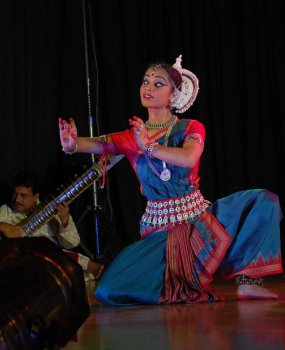 Supriya Nayak Supriya Nayak, the last artiste of the first evening commenced her recital with Sthai of the Guru Debaprasad Das's style, in chowka position in slow tempo and through a series of movements gradually gathered momentum. Neat mellifluous movement, stretching of the legs with the swara "tam thai ta kita taka ta ham ta hata ta," and circular movements spoke of the dancer's assiduous training. Correct comprehension of what is to be performed is definitely required, but the artist herself reading about her item from a paper perplexed and the resulting verbal mistakes were unacceptable. The abhinaya pieces in Oriya "Bata Charu suha koro Yamuna Jibi" choreographed by Kiran Segal somewhat concomitant to Guru Kelucharan Mohapatra's masterpiece "Patha chari dae mu jibi phulo tori… bonomali" and "Rasa Rangini Rae" were executed neatly. Clear abhinaya surfaced from the beginning. Supriya concluded her recital with "Jago Maheshwaro Jogi Digambara" propitiating the rudra roopa of Lord Shiva. The tandava movements executed through the usage of various bols was interspersed with the sahitya "Bibhuti Bhushita Jata Juta Shira" and the charis concomitant to the tandava aspect of the Odissi form was mesmerizing. 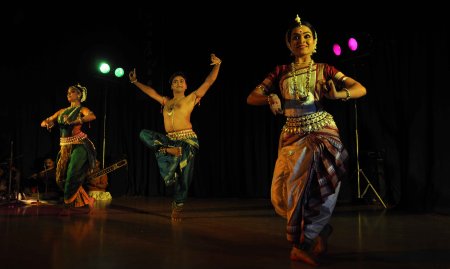 Sashwati, Biswajit and Rajashri performing mangalacharan The second day of the festival March 27th commenced with the three performers of the evening Sashwati Garai Ghosh, Biswajit Das and Rajashri Praharaj paying obeisance to Lord Padmanabha through "Shanta karam bhujanga sayanam" choreographed as Mangalacharan. With Biswajit as Padmanabha, the aficionados witnessed beautiful choreography. 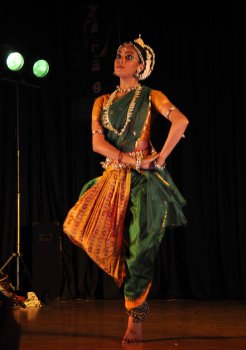 Sashwati Garai Ghosh Sashwati Garai Ghosh from Kolkata, the first artist of the evening commenced her recital with a Gati Bilas Pallavi choreographed by Kolkata based Sharmila Biswas. The choreography spoke of the movements of the birds, animals. Petite this dancer is, yet raising her chin up at an unacceptable level and very less eye contact with the rasikas mars the aesthetic beauty of Sashwati abhinaya and she concluded her recital with Krishna Janma Katha. 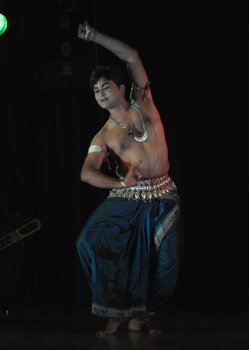 Biswajit Das Biswajit Das, a handsome dancer from Bhubaneshwar was an apt choice for the second slot. Commencing his recital with "ta ta ri ta jhena" Pallavi set to Raag Bilahari choreographed by Guru Kelucharan Mohapatra with the music composition by Bhubaneswar Mishra in eka taali, the dancer with his immense stage presence caught the eye of the connoisseurs. Entering the proscenium with the "dhi na tae nak dhin ta" rhythmic swara, Biswajit created an immediate rapport with the audience. His neat movements forming a square, the linear circular charis, the correctly executed Dakshyachala, Bamachala, Utchala and Prustha Chala - the variations of chowk, aggrandized the overall effect. Biswajit's body was always in resolute control, manifesting a superb kinetic gusto while executing the charis beautifully. The asthapadi "Maamiyam chalita bilokhya" choreographed by Aruna Mohanty shows Krishna repenting for his mistakes in being with other Gopikas even when Radha truly loves him. One must appreciate Biswajit's attempt to execute such a critical abhinaya with Krishna in woe. Usage of Srikhol amongst the other music ensemble to embellish the charis as choreographed for Lord Krishna was aesthetic. 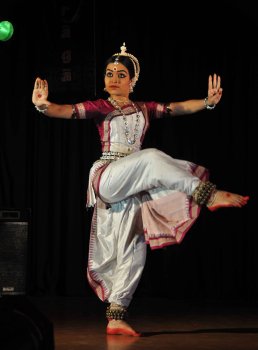 Rajashri Praharaj Rajashri Praharaj from the Kelubabu school of Odissi, the finale for the entire festival commenced with stuti "Jaya Mahesha Jata Juta" propitiating Lord Shiva. Mellifluous lyrics "Chandra sohi kala kuta" making a melodious rhyming scheme interspersed with the swaras "tai dhinak ta tunga" accompanied by Ratikant Mohapatra on the pakhawaj in a quality prerecorded sound tape accentuated the overall effect. The utmost lyrical "Ta na di rae na" pallavi with the swaras congruous to rain in Raag Megha demands a standing ovation for both the music and the dance composition. The "ta ri jhena jhenu" swara with Rajashri traversing the space in an organic flow using various permutation and combination of the chowks and tribhangas prove the dancer's mettle in imbibing the nritta genre of the form perfectly. Tastefully costumed, the neat asymmetrical tribhangi position of her body with the neat squat as executed while drawing the chowk demands appreciation. Neat head inclination with the chin down in the correct angle, continuous eye contact with the rasikas enhanced her abhinaya ingredient in Ratikant's choreography of the piece de resistance of the last evening "Sri Rama Chandra Kripalu Bhajamana." The piece pivoted around two episodes from Ramayana - the Sita Swayamvara and the Ravana Mardana. One must genuflect the artist's displaying her abhinaya skills while lifting the bow in Sita's swayamvara by the disputed kings whose perplexed expressions were revealed through Rajashri's subtle facial abhinaya while failing to uplift the same. Neat masculine movements of Rama merged beautifully with that of the lasya aspect of Sita. Not a slightest overdo manifested in the fight sequence of the Ravana Mardana episode. The piece concluded with an encomium paid to Rama through "Jaya Jaya Ram" with the vocalist Rupak's bhakti filled melodious voice rendition spoke for a rounded performance. Above all, Odissi dancer Ramesh Chandra Jena's artistic lighting and Milan's announcement for both the days in chaste Oriya made the festival a memorable event. Probal Gupta trained in Kathakali under two legends Late Kalamandalam Govindan Kutty and Guru Fact Padmanabhan under whom he is presently continuing his specialization in Stree Vesham genre of Kathakali. He has also been a student of Bharati Shivaji. He is an empanelled artist of Doordarshan and has established a Solo Margam for Stree Vesham Kathakali under the able guidance of his Guru Fact Padmanabhan. Probal is a graduate in English Hons from the University of Kolkata. He writes for the Bangalore edition of The Hindu. |